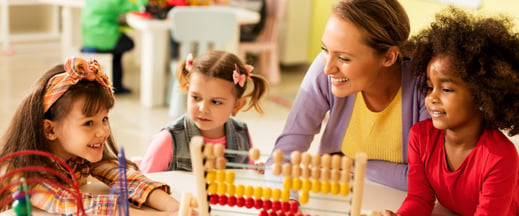
Who was your favorite teacher?
For Darlene Estes, Teachstone’s Director of Strategic Partnerships, it was her first grade teacher. Along with Sarah Hadden, Teachstone’s Senior Advisor for Policy & Research, she explored the reasons why in a recent webinar: her teacher built a personal relationship with her. She helped a young Darlene feel welcome and safe. She challenged Darlene to think.
The reason Darlene’s first grade teacher was so memorable is because she embodied the heart of great teaching. These powerful interactions are what are measured by the Classroom Assessment Scoring System®, or CLASS®. Together, Darlene and Sarah guided CLASS beginners through some foundational ideas about what CLASS is and how to start thinking more intentionally about teacher-child interactions. Here are three big takeaways:
1. CLASS is the most evidence-based and widely used continuous improvement system for teaching in early childhood settings.
Although the CLASS tool is used and applicable across the K-12 range, it is most widely used in programs and environments serving children birth to five years old. The daily interactions children have with their caregivers and educators lay a foundation for their future growth and development. These interactions aren’t just something nice to have while getting to the “real” learning–they are how young children learn. In fact, the types of interactions measured by CLASS are critical to children’s academic, language, cognitive, social, emotional, and self-regulation outcomes.
These aren’t new revelations. In fact, it’s been nearly 30 years since the foundational research that led to the development of the CLASS. The tool is now used in 23 states’ rating systems and in over 40 countries across the world. Researchers across cultures have found positive relationships between each of the three CLASS domains of Emotional Support, Classroom Organization, and Instructional Support. From soft skills (like behavior regulation and social competence) to the more technical (like math, language, literacy, and executive functioning), teaching that’s grounded in high-quality interactions leads to stronger outcomes.
2. The CLASS framework helps educators focus, measure, and improve the critical, day-to-day interactions that drive effective teaching and learning.
Many of those new to CLASS know it as an observation tool. And it is! However, it’s also paired with resources to help organizations begin to focus on the importance of high-quality interactions, measure those interactions in an ongoing way, and improve program quality with aligned, data-driven professional development and coaching.
Used as a continuous process, CLASS transforms from an observation or accountability tool to so much more. When leaders have reliable data, they can make informed decisions about resources, like staffing and professional development. When coaches can narrow in on what teachers and their students need most, they can give meaningful, specific feedback and systematically watch for improvement. And when teachers learn more about tangible actions to take that will better support their students’ learning, they are empowered to build on existing classroom practices and activities. With all the pieces of this cycle in place, programs see success for educators and children alike.
3. Teachstone has resources for teachers, coaches, observers, and leaders to dive deeper into their CLASS journeys.
Buy-in is critical. If teachers, coaches, leaders, and all instructional staff aren’t on board, making change for kids is incredibly challenging. It doesn’t need to - and shouldn’t - feel like an add-on to teachers’ work. As Sarah put it, “The authors of CLASS didn’t invent good teaching. What they did is they watched good teaching, and figured out ways to quantify it, and gave us a vocabulary so we can all talk about it together.”
That’s why Teachstone offers many resources to support all educators along your organization’s CLASS journey. At the focus stage, teachers, coaches, and leaders can build knowledge about quality interactions through a virtual course like CLASS Primer, or see specific video examples. Organizations can build capacity to measure with observation and coaching training, helping instructional leaders dig deeply into their understanding of CLASS. And tools like the CLASS strategy cards or virtual courses can help teachers plan to build on their strengths as educators in an intentional, strategic way.
CLASS is all about interactions. It’s not something “more” to do or another initiative - it’s simply intentionally strengthening what educators do best. Whether you are brand new to the classroom or have been teaching for decades, Teachstone is excited to help you be your best for students with CLASS.
Watch the full webinar

